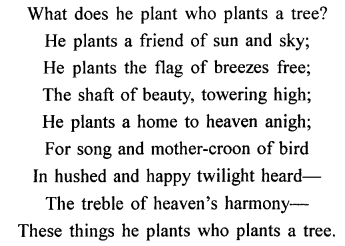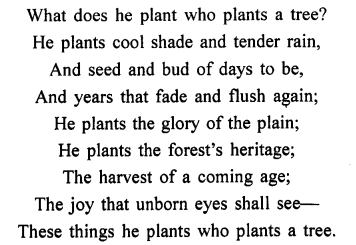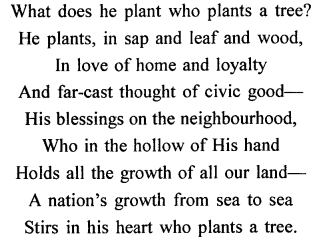Treasure Trove A Collection of ICSE Poems Workbook Answers Chapter 1 Notes – The Heart of a Tree – ICSE Class 10, 9 English
EnglishMathsPhysicsChemistryBiology
ICSE SolutionsSelina ICSE SolutionsML Aggarwal Solutions
About the Poet
Henry Cuyler Bunner was born in Oswego, New York to Rudolph Bunner, Jr. (18131875) and Ruth Keating Tuckerman (1821-1896) and was educated in New York City.
From being a clerk in an importing house, he turned to journalism, and after working as a reporter, and on the staff of The Arcadian (1873), he became in 1877 an assistant editor of the comic weekly Puck. He soon assumed the editorship, which he held until his death. He developed Puck from a new struggling periodical into a powerful social and political organ. In 1886, he published a novel, The Midge, followed in 1887 by The Story of a New York House. But his best efforts in fiction were his short stories and sketches Short Sixes (1891), More Short Sixes (1894), Made in France (1893), Zadoc Pine and Other Stories (1891), Love in Old Clothes and Other Stories (1896), and Jersey Street and Jersey Lane (1896). His verses Airs from A ready and Elsewhere (1884), containing the well-known poem, The Way to Arcady; Rowen (1892); and Poems (1896), displaying a light play of imagination and a delicate workmanship. He also wrote clever parodies.
Bunner married Alice Learned (1863-1952), daughter of Joshua Coit Learned (1819— 1892), and granddaughter of Joshua Coit (1758-1798), U.S. Representative from Connecticut. Bunner died on May 11, 1896 in Nutley, New Jersey.
The position which Henry Cuyler Bunner has come to occupy in the literary annals of our time strengthens as the days pass. If the stream of his genius flowed in gentle rivulets, it traveled as far and spread its fruitful influence as wide as many a statelier river. He was above all things a poet. In his prose as in his verse he has revealed the essential qualities of a poet’s nature: he dealt with the life which he saw about him in a spirit of broad humanity and with genial sympathy.
The work upon which Bunner’s fame must rest was all produced within a period of less than fifteen years. He was born in 1855 at Oswego, New York. He came to the city of New York when very young, and received his education there. A brief experience of business life sufficed to make his true vocation clear, and at the age of eighteen he began his literary apprenticeship on the Arcadian. When that periodical passed away, Puck was just struggling into existence, and for the English edition, which was started in 1877, Bunner’s services were secured. Half of his short life was spent in editorial connection with that paper. To his wisdom and literary abilities is due in large measure the success which has always attended the enterprise. Bunner had an intimate knowledge of American character and understood the foibles of his countrymen; but he was never cynical, and his satire was without hostility. He despised opportune journalism. His editorials were clear and vigorous; free not from partisanship, but from partisan rancor, and they made for honesty and independence. His firm stand against political corruption, socialistic vagaries, the misguided and often criminal efforts of labor agitators, and all the visionary schemes of diseased minds, has contributed to the stability of sound and self-respecting American citizenship.
About the Poem
It is a poem which shows the poets affinity with nature. The Heart of the Tree also subtitled as an Arbor-day Song and was written in April 1893. It is a comment on the benefits of planting a tree. Divided into three stanzas the poem tells us about the various benefits of planting a tree. Each stanza opens with the same question: What does he plant who plants a tree? The poet then provides answers himself. He who plants a tree, plants many things: the gentle sunshine, cool, free breezes, beauty, music and harmony. He ensures cool shade and tender rain. The one who plants a tree is conscious about the well being and growth of his country and in fact leaves a invaluable legacy for future generations. The poet tells us that trees are a boon for our environment and are symbolic of innumerable things . He motivates us to plant trees.
Central Idea
Heart of Trees relates to the cycle of life that is very evident in the growth of a tree, which germinates in soil, grows and flourishes, then dies, decays and returns to the soil to support new saplings. Transformation is the central concept and reveals interest in the way that something exceptional can be produced from a simple beginning, that base matter can give life to something infinitely more elaborate. This relationship mirrors the pairing of body and soul, the body being material and limited in scope, and the soul being immaterial and boundless. As the tree grows we can imagine that it may either break the shackles of the body that surrounds it, or be smothered by it; a conflict that represents the relationship between body and soul.
The poem highlights the need to plant trees as it benefits all and sundry. A tree not only provides shade and cool breeze but it also is a legacy for future generations and binds the present to the future. It represents values like love and loyalty. One who plants trees not only ensures the development of his nation but also the peace and prosperity of the world. Thus, the poet tells us that planting a tree has ecological, social and economic advantages. In fact a tree according to him is a metaphor for peace, growth, beauty, harmony and prosperity.
Word Meanings
- Shaft – a ray of light or bolt of lightning, body of a spear or arrow, or similar.
- Towering – extremely tall, especially in comparison with the surroundings.
- Anigh – (archaic) near, close
- Croon – hum or sing in a soft, low voice, especially in a sentimental manner.
- Hushed – (of a voice or conversation) quiet and serious.
- Twilight – the soft glowing light from the sky when the sun is below the horizon, caused by the reflection of the sun’s rays from the atmosphere, ambiguity, or gradual decline.
- Treble – consisting of three parts; threefold.
- Days to be – days to come,future.
- Harmony – the combination of simultaneously sounded musical notes to produce a pleasing effect.
- Flush – (of a person’s skin, face, etc.) become red and hot, typically as the result of illness or strong emotion.
- Heritage – property that is or may be inherited; an inheritance.
- Harvest – reward
- Coming age – Coming of age is a young person’s transition from being a child to being an adult. The certain age at which this transition takes place changes in society, as does the nature of the change. … It can be a simple legal convention or can be part of a ritual or spiritual event, as practiced by many societies.
- Unborn eyes – unborn children
- Sap – the fluid which circulates in the vascular system of a plant, consisting chiefly of water with dissolved sugars and mineral salts.
- Far-cast – wide
- Civic – relating to a city or town, especially its administration; municipal.
- From sea to sea – all the world
- Stirs – moves, arouses a feeling.
Paraphrase
Stanza 1

Paraphrase
When a man plants a tree he plants many things. He plants a congenial environment. A tree reduces temperature Wand purifies the atmosphere as it traps dust , pollen and smoke. It ensures cool and gentle breezes. Thus it is truly, ‘a friend of sun and sky.’ It makes a heaven on earth as a green place is truly a heaven. One who plants a tree provides safe haven for birds whose sweet crooning in silent and happy twilight delights us. One who plants a tree ensures peace, harmony and comfort for himself and others.
Stanza 2

Paraphrase
What does he plant who plants a tree? A simple answer. One who plants a tree provides cool shade in summer and tender rain in all seasons which are essential for existence of life on this planet. A tree gives us seeds which sprout, and buds which bloom in times to come. It is a forest heritage as one tree leads to a whole forest in the future and a’ harvest of a coming age or in other words a reward and legacy for the future in the form of wood and a congenial environment. It provides benefits in the present and in the times to come. In fact it provides a link between us and our future generations.
Stanza 3

Paraphrase
When a tree is planted many benefits accrue. Values like love and loyalty are planted in the form of a tree. We learn to nurture and grow with love. The there is a civic good in planting a tree. It benefits the neighbours around. A county’s growth and development depends on the wealth of its trees. One who plants a tree is aware about this fact as a ‘nation’s growth from sea to sea Stirs in his heart who plants a tree.’ Thus the world prosperity and peace is represented in the planting of a tree.
Summary
The poet emphasises the advantages of planting a tree. In every stanza he poses the question, ‘What does he plant who plants a tree?’ And the answer he simply provides is that the one who plants a tree ensures cool shade and tender rain in summer. The planting of a tree makes the atmosphere fresh and pollution free giving peace and comfort not only to the one who plants a tree but to all and sundry.
The poet the repeats his question and answers that one who plants a tree provides cool shade in summer and tender rain in all seasons which are essential for existence of life on this planet. A tree gives us seeds which sprout, and buds which bloom in times to come. It is a forest heritage as one tree leads to a whole forest in the future and a’ harvest of a coming age or in other words a reward and legacy for the future in the form of wood and a congenial environment. It is a link of the present to the future.
Finally the poet says that Values like love and loyalty are planted in the form of a tree. We learn to nurture and grow with love. The there is a civic good in planting a tree. It benefits the neighbours around. A county’s growth and development depends on the wealth of its trees. Thus the poet feels that the planting of a tree leads to social, ecological and economic growth and prosperity and is a metaphor for peace, harmony, growth and pollution free environment.
Critical Appreciation
The message is that a tree is more symbolic than meets the eye. It is a heart, and whenever a heart is planted it will sprout into beaming life, and will create new life! Trees are a fundamental image for alchemists. The roots are in dead matter, minerals, earth, and they are able to create life. The trunk is like a bridge; and the branches are a link to the cosmos. The philosophical tree was represented as growing out of a man’s sex and a woman’s head. Alchemists claimed that when humans died, dead matter gave birth to a new life. The tree was a metaphor for transformation.
The poet uses similes and metaphors to describe what a tree. He uses literary devices like metaphors, alliteration and imagery in the poem. The poet describes the tree metaphorically: ‘a friend of sun and sky,’ ‘the flag of breezes free.’
He uses alliteration when he says: He plants a friend of sun and sky.
In hushed and happy twilight heard’
Visual Imagery is used in the poem: The shaft of beauty, towering high:, ‘ the flag of breezes free. ’ And auditory imagery is also used : ‘For song and mother-croon of bird.”
Repetition is used to show how a person should feel after he/she plants a tree. The first line of the poem, “What does he plant who plants a tree?” is repeated three times, and is followed by, “These things he plants who plants a tree,” which is repeated twice, and on the last line it says, “A nation’s growth from sea to sea (new line) Stirs in his heart who plants a tree.” All put together it tells you that this man thinks that planting a tree is like planting a new nation and it will bring peace and harmony to the Earth!
The tone of the poem is rhetorical and motivating. The rhyme scheme is ababbccda, ababbccaa, ababbccaa.The poem is in the form of a short lyric consisting of three stanzas. It creates good rhythm and music and like a good lyric incorporates only a single emotion and appeals to our hearts at once.
Though the poem was written many years ago when there was little importance given to ecology and environment yet it is relevant today also because it tells us that trees are an integral and important part of our ecological and economic growth and environmental well -being. In our times forests are being decimated for building houses, roads and bridges. Trees seem to attract none of our concern. But in the poem the poet draws our attention to the advantages of planting trees. He rightly says that one who plants trees, plants many things: beauty, peace, shade, harmony and good values.
The tree is used as a symbol of all the good in our lives. It symbolises peace and prosperity in our country and in the world. It teaches the vales of love and loyalty. It symbolises rich rewards for our future generations and represents a link of our present with the future. It stands as a symbol of growth, prosperity and harmony.
The title of the poem is very apt and suggestive. The tree is the main focus in the poem and the poet refers to the heart of the tree. What kind of heart is it- it is generous, loving and magnanimous. It shows no discrimination based on colour or creed. It blesses all alike- all who take care of it and even those who neglect it. Whenever a tree is planted it turns the earth into a heaven and the poet rightly says:
The shaft of beauty, towering high:
He plants a home to heaven anigh.
Thus the poet in his lyrical poem motivates us to plant trees for our own and the world’s development and harmony.
For More Resources
